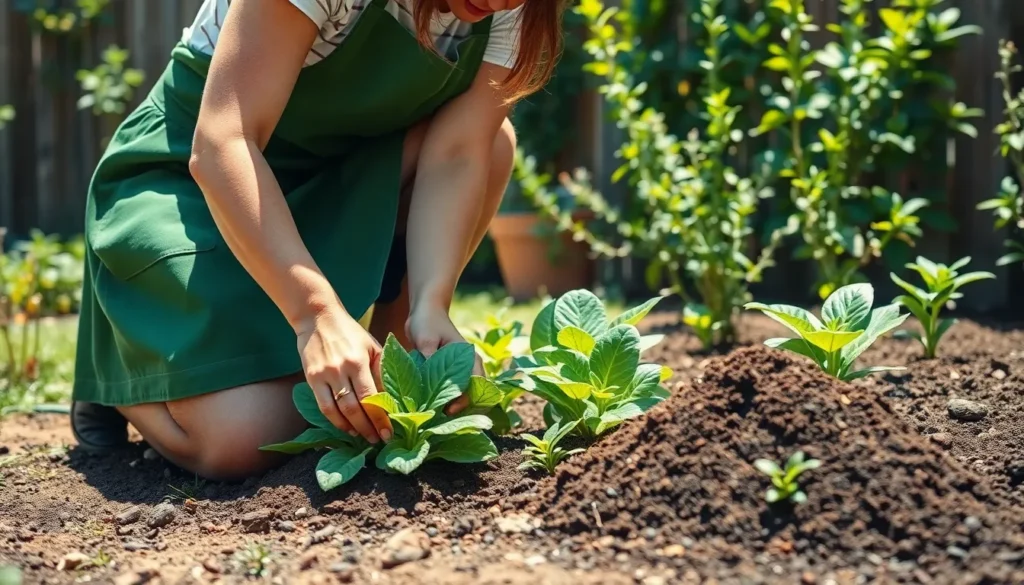We’ve all been there – standing in our kitchen with a fresh pot of coffee brewing while staring at yesterday’s used grounds heading straight for the trash. What if we told you those “waste” grounds could transform your garden into a thriving paradise? Coffee grounds aren’t just morning fuel remnants; they’re a gardener’s secret weapon packed with nutrients your plants crave.
Every year millions of pounds of coffee grounds end up in landfills when they could be enriching our soil instead. These nutrient-rich leftovers contain essential elements like nitrogen phosphorus and potassium that plants desperately need to flourish. From boosting acidic soil conditions for your blueberry bushes to creating the perfect compost blend coffee grounds offer incredible benefits that most gardeners overlook.
We’re about to reveal exactly how to harness this free abundant resource to create healthier soil stronger plants and bigger harvests. Your morning coffee routine is about to become your garden’s best friend.
Coffee Grounds Provide Essential Nutrients for Plant Growth
Used coffee grounds contain three key nutrients that directly fuel plant development. These macronutrients work together to create optimal growing conditions for our garden plants.
Nitrogen Content Boosts Leafy Green Development
Coffee grounds contain approximately 2% nitrogen by weight, making them an excellent organic fertilizer for leafy vegetables and herbs. Nitrogen serves as the primary building block for chlorophyll production, which gives plants their vibrant green color and enables photosynthesis.
We find that lettuce, spinach, kale, and other leafy greens respond exceptionally well to coffee ground applications. The slow-release nature of nitrogen in coffee grounds prevents burning while providing steady nutrition throughout the growing season. Fresh coffee grounds release nitrogen more quickly than composted ones, so we recommend using them sparingly around established plants.
Nitrogen deficiency appears as yellowing leaves starting from the bottom of the plant, but coffee grounds help prevent this common issue. The organic matter in coffee grounds also improves soil structure, allowing roots to access nitrogen more efficiently.
Phosphorus Supports Root System Strength
Coffee grounds contain roughly 0.3% phosphorus, an essential nutrient for robust root development and flower formation. Phosphorus plays a crucial role in energy transfer within plants and helps establish strong root networks that support overall plant health.
Root vegetables like carrots, radishes, and beets benefit significantly from the phosphorus in coffee grounds. We’ve observed improved root density and length when coffee grounds are mixed into the soil before planting. Flowering plants such as tomatoes, peppers, and roses also show enhanced bloom production with regular coffee ground applications.
The phosphorus in coffee grounds becomes available gradually as microorganisms break down the organic matter. This slow release prevents phosphorus toxicity while ensuring plants receive consistent nutrition during critical growth phases.
Potassium Enhances Overall Plant Health
Coffee grounds provide approximately 0.6% potassium, supporting disease resistance, water regulation, and fruit development. Potassium strengthens cell walls and helps plants withstand environmental stresses like drought, cold temperatures, and pest attacks.
Fruit-bearing plants including strawberries, blueberries, and citrus trees show improved fruit quality when coffee grounds are incorporated into their feeding regimen. We notice better flavor development and increased fruit size in plants that receive regular coffee ground applications. The potassium content also helps regulate water movement within plants, reducing wilting during hot weather.
Potassium deficiency typically manifests as brown leaf edges and poor fruit development, but coffee grounds help maintain adequate potassium levels naturally. The organic potassium in coffee grounds remains available longer than synthetic fertilizers, providing sustained nutrition throughout the growing season.
Coffee Grounds Improve Soil Structure and Drainage
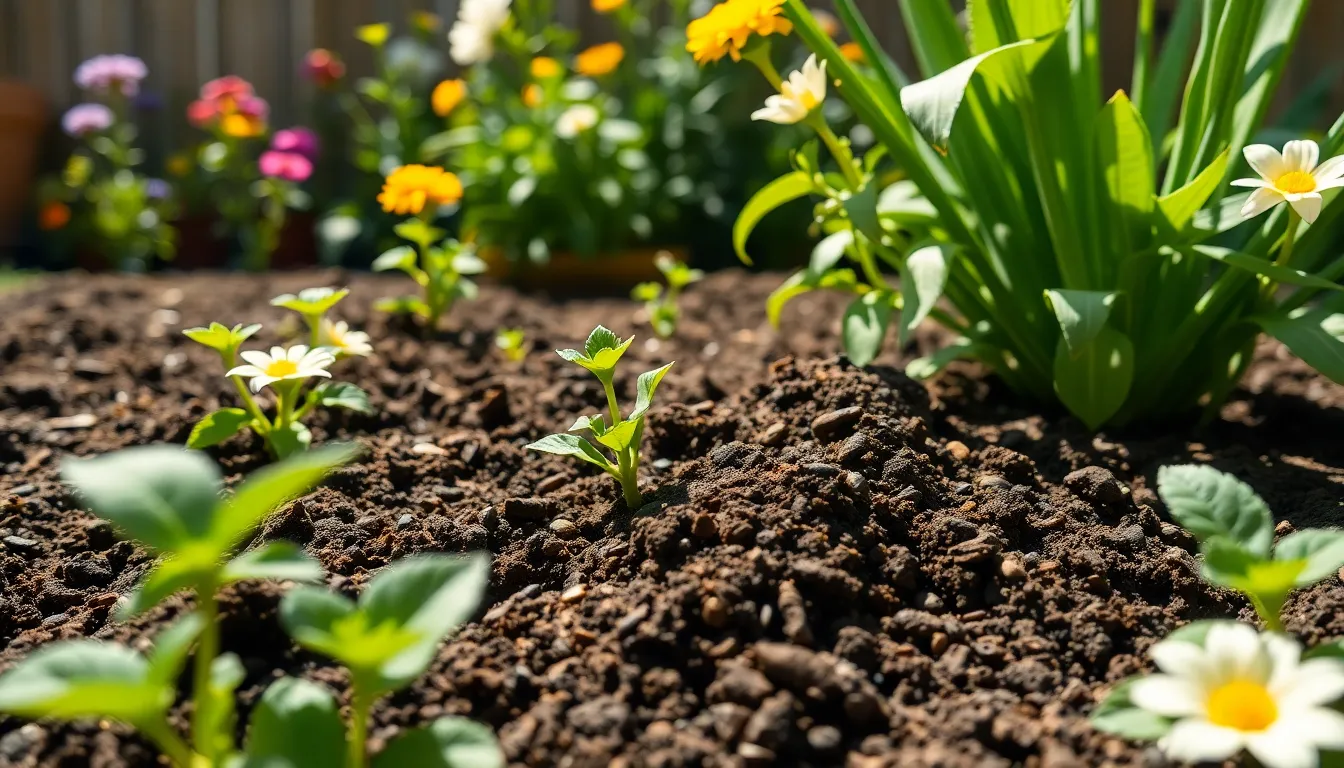
Coffee grounds work as a natural soil conditioner that transforms the physical properties of your garden soil. We’ve discovered that these nutrient-rich amendments create important improvements in both soil structure and drainage capabilities.
Enhanced Water Retention in Sandy Soils
Sandy soils struggle with water retention issues that leave plants thirsty and stressed. Coffee grounds act like tiny sponges within the soil matrix, absorbing and holding moisture for extended periods. We find that gardens with sandy soil benefit tremendously from this natural amendment because it reduces watering frequency while maintaining consistent moisture levels.
Organic matter from coffee grounds creates water-holding pockets throughout sandy soil structures. Plants access this stored moisture gradually, which supports steady growth even during dry spells. We recommend mixing coffee grounds directly into sandy garden beds to maximize their water retention benefits.
Better Aeration in Clay-Heavy Soil Types
Clay soils present unique challenges with their dense, compacted structure that restricts air movement. Coffee grounds break up clay particles and create air channels that allow roots to breathe more effectively. We observe that clay-heavy soils become more workable and less prone to waterlogging when amended with used coffee grounds.
Root systems develop more extensively in clay soils treated with coffee grounds because improved aeration supports healthier root growth. Oxygen reaches plant roots more easily, which enhances nutrient uptake and overall plant vigor. We’ve seen important improvements in root development when coffee grounds are incorporated into clay garden areas.
Increased Organic Matter Content
Organic matter content increases substantially when we add coffee grounds to garden soil. Coffee grounds contain approximately 2% nitrogen, 0.3% phosphorus, and 0.6% potassium, which enrich soil fertility over time. We know that used coffee grounds maintain a near-neutral pH between 6.5 and 6.8, making them suitable for most garden applications without acidifying the soil.
Soil structure improves as coffee grounds decompose and integrate with existing organic matter. Premium coffee grounds often provide richer nutrient profiles compared to standard varieties, giving plants access to higher quality soil amendments. We recommend using coffee grounds as both direct soil additions and compost ingredients to maximize their organic matter contributions.
Coffee Grounds Attract Beneficial Garden Organisms
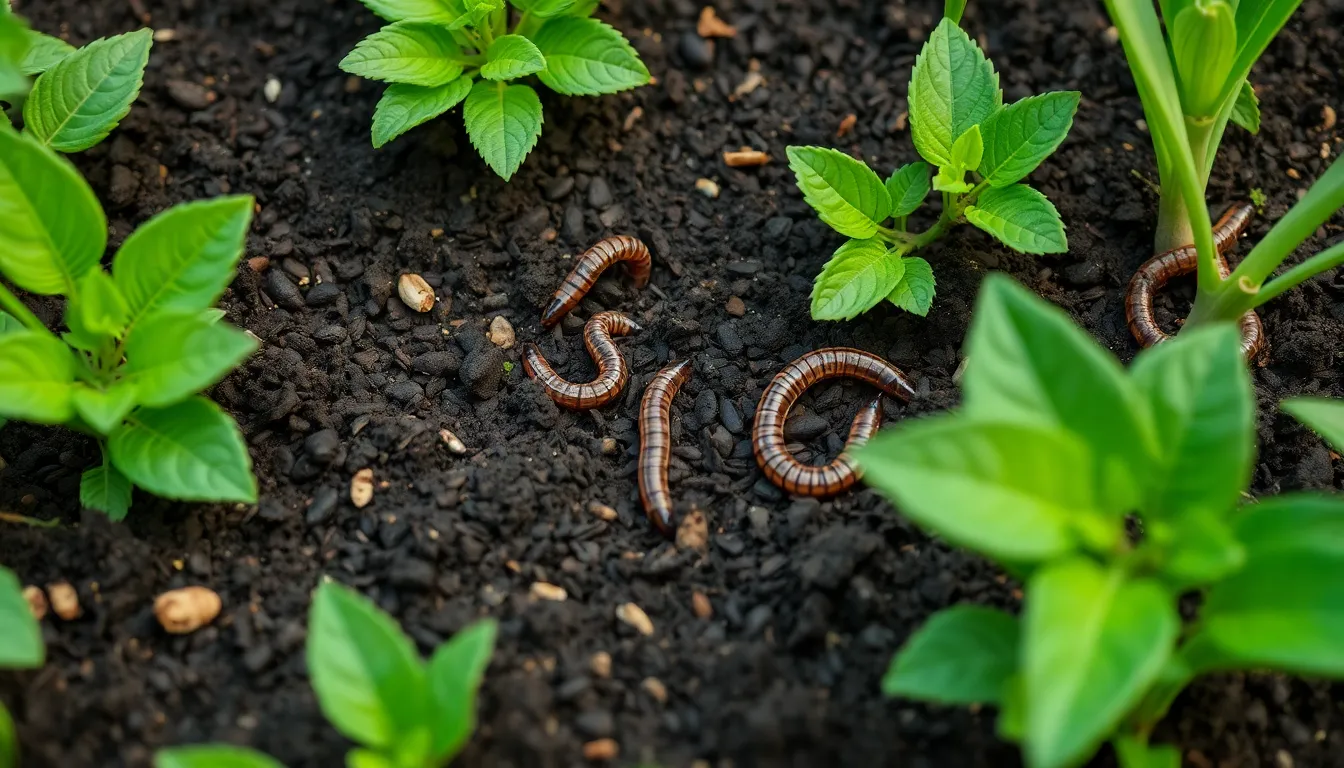
Beyond improving soil structure and providing nutrients, coffee grounds create an environment that naturally attracts and supports beneficial garden organisms. These organisms work alongside our plants to create healthier, more productive growing conditions.
Earthworms Thrive in Coffee-Enriched Soil
Earthworms find coffee-enriched soil irresistible, creating thriving populations that dramatically improve our garden health. When we add coffee grounds to our soil, earthworms multiply rapidly because they feed on the organic matter and enjoy the improved soil conditions. These beneficial creatures enhance soil aeration by creating tunnels as they move through the earth, allowing better oxygen flow to plant roots.
Working tirelessly beneath the surface, earthworms break down organic materials and mix different soil layers together. Their natural activity increases nutrient availability by processing organic matter into forms that plants can easily absorb. Castings produced by earthworms contain higher concentrations of nitrogen, phosphorus, and potassium than regular soil, providing our plants with premium nutrition.
Beneficial Bacteria Multiply More Rapidly
Beneficial bacteria populations increase significantly when we incorporate coffee grounds into our garden soil. Coffee grounds provide an ideal food source for these microscopic helpers, encouraging them to reproduce faster than in untreated soil. These bacteria play crucial roles in breaking down organic matter and releasing nutrients that plants need for optimal growth.
Colonies of beneficial bacteria work to suppress harmful pathogens that can damage our plants. They compete for resources with disease-causing organisms, creating a natural defense system in our soil. Nitrogen-fixing bacteria particularly benefit from coffee ground additions, helping convert atmospheric nitrogen into forms our plants can use.
Microorganisms Break Down Organic Materials Faster
Microorganisms accelerate decomposition processes when coffee grounds are present in our soil network. These tiny organisms use coffee grounds as fuel, speeding up the breakdown of leaves, stems, and other organic debris that accumulate in our gardens. Faster decomposition means nutrients become available to our plants more quickly than in standard soil conditions.
Fungal networks expand more rapidly in coffee-enriched environments, creating beneficial relationships with plant roots. These microorganisms form partnerships with our plants, exchanging nutrients for carbohydrates in mutually beneficial arrangements. Enhanced microbial activity also improves soil structure over time, creating better growing conditions that support long-term garden health.
Coffee Grounds Repel Common Garden Pests Naturally
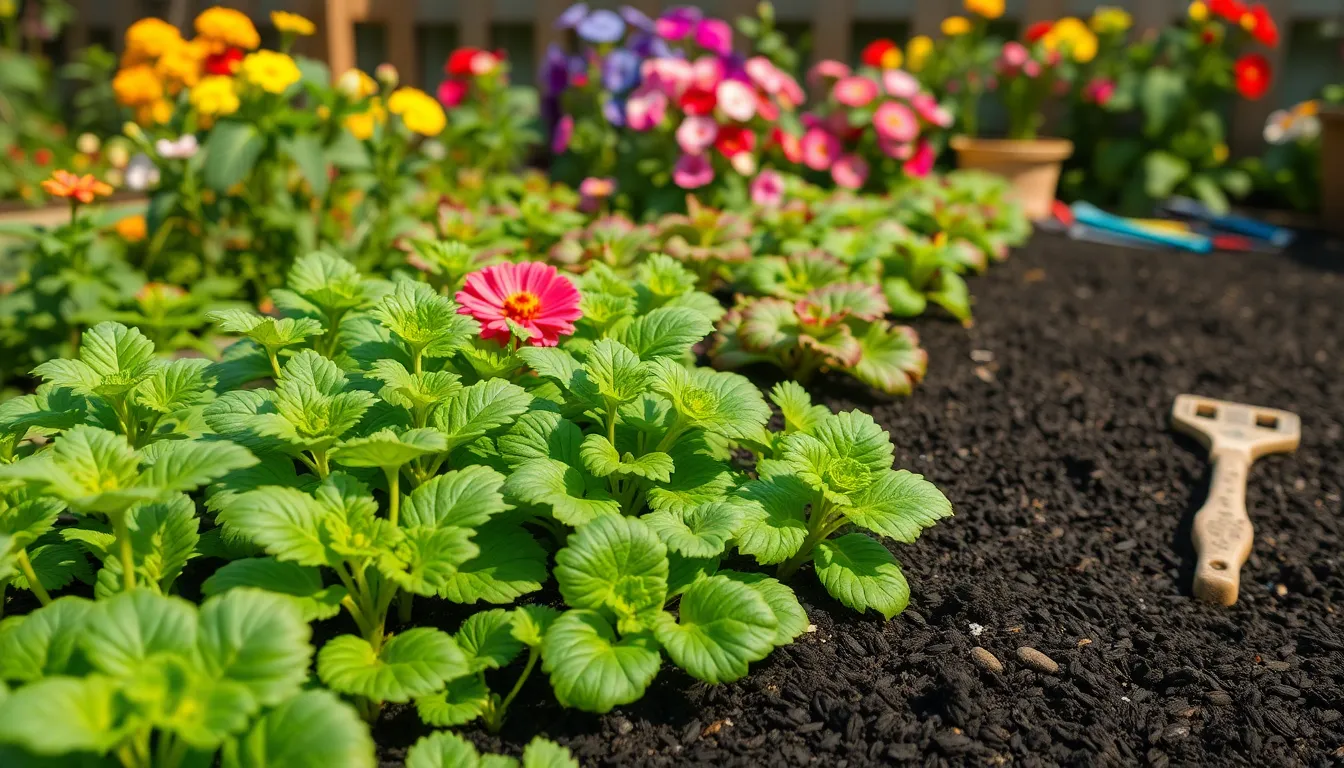
While coffee grounds enhance soil quality and plant nutrition, they also serve as an effective natural deterrent against several troublesome garden pests.
Slugs and Snails Avoid Coffee-Treated Areas
Research from Oregon State University demonstrates that coffee grounds create powerful barriers against these slimy invaders. Scientists found that using a 1%-2% coffee solution as a soil drench caused 100% of slugs to leave treated areas immediately. We can apply this natural deterrent by sprinkling used coffee grounds around vulnerable plants like lettuce, hostas, and young seedlings.
Fresh coffee grounds work more effectively than aged ones for slug control due to their higher caffeine content. Gardeners should create protective rings around susceptible plants, refreshing the coffee ground barriers every few weeks. The texture and chemical compounds in coffee grounds make these areas uninhabitable for slugs and snails, forcing them to seek feeding grounds elsewhere.
Cats Stay Away from Coffee Ground Barriers
Coffee grounds create natural boundaries that effectively discourage cats from entering garden spaces. The strong aroma acts as a sensory deterrent that most felines find unpleasant, protecting flower beds and vegetable patches from unwanted digging and waste deposits.
We recommend spreading a thin layer of used coffee grounds around garden perimeters and near favorite feline gathering spots. Combining coffee grounds with other natural cat deterrents like citrus peels amplifies the repelling effect. Regular reapplication after rain ensures consistent protection throughout the growing season.
Certain Insects Find Coffee Grounds Deterrent
Many garden pests with strong scent detection abilities avoid areas treated with coffee grounds. The potent aroma disrupts their navigation and feeding patterns, making treated plants less attractive targets. But, we must use coffee grounds selectively since their strong scent can also repel beneficial insects like pollinators.
Applying coffee grounds directly around the base of plants creates targeted protection zones without affecting entire garden ecosystems. Focus applications on plants frequently attacked by aphids, spider mites, and other soft-bodied insects. Monitor beneficial insect activity to ensure we’re not inadvertently harming helpful garden visitors while controlling pests.
Coffee Grounds Work Best with Acid-Loving Plants
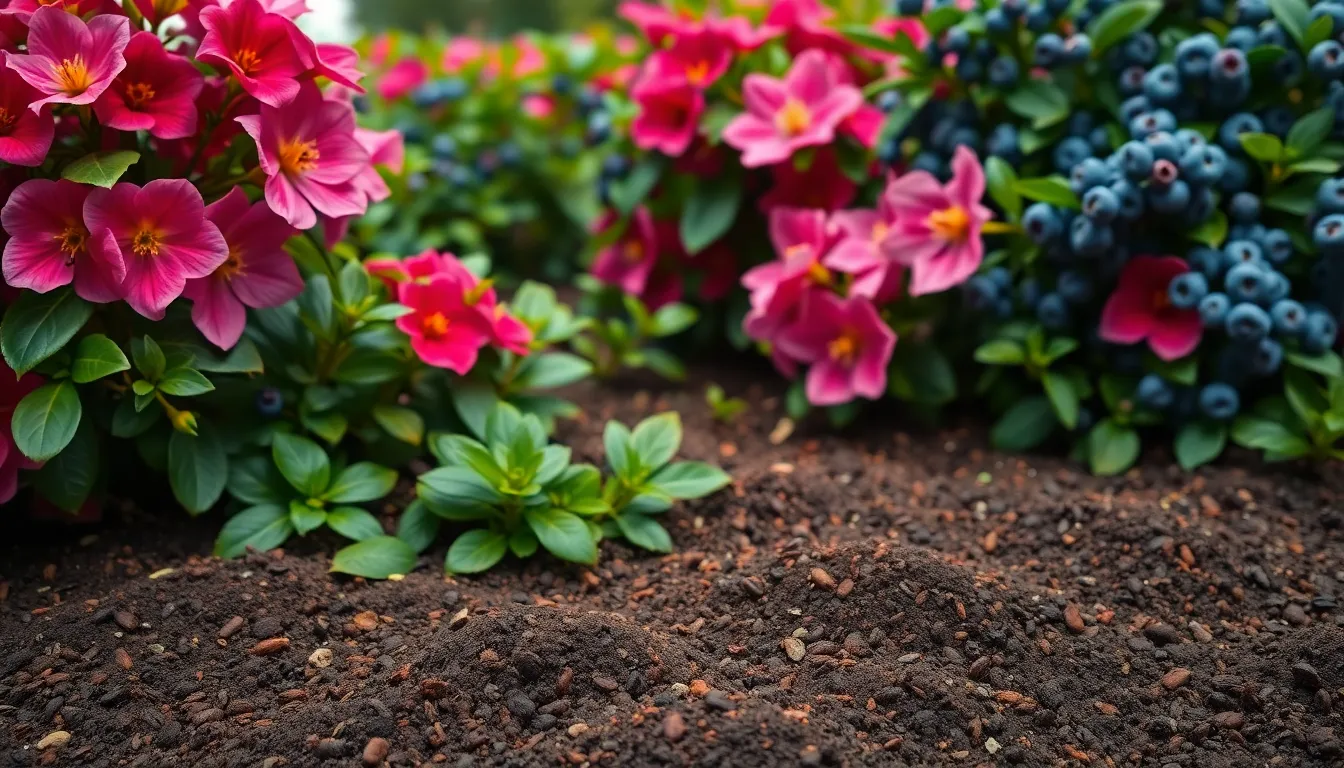
While coffee grounds provide benefits for many plants, they deliver the most impressive results when paired with species that naturally prefer slightly acidic growing conditions.
Blueberry Bushes Flourish with Coffee Applications
Blueberry bushes thrive when we incorporate coffee grounds into their soil management routine. These berry-producing plants naturally prefer acidic conditions with a pH around 4.5 to 5.5, making them ideal candidates for coffee ground amendments. Studies show coffee grounds maintain an average pH of 6.2 after decomposition, creating the slightly acidic environment blueberries need for optimal nutrient uptake.
Enhanced soil texture becomes particularly beneficial for blueberry root systems, which are shallow and fibrous. Coffee grounds improve moisture retention around these delicate roots while providing essential nutrients like nitrogen, phosphorus, and potassium. Research indicates blueberry plants show increased fruit production and stronger overall health when coffee grounds are worked into the soil at planting time or applied as a seasonal mulch.
The slow release nitrogen content in coffee grounds supports steady growth throughout the growing season without causing excessive vegetative growth that could reduce fruit quality. We recommend applying a thin layer of coffee grounds around established blueberry bushes in early spring, working them gently into the top few inches of soil.
Azaleas and Rhododendrons Benefit Significantly
Azaleas and rhododendrons respond exceptionally well to coffee ground applications due to their preference for acidic, well draining soil conditions. These ornamental shrubs naturally thrive in pH ranges between 4.5 and 6.0, positioning them perfectly to take advantage of the mild acidifying effects coffee grounds provide over time.
Scientific studies demonstrate that coffee grounds help maintain the slightly acidic soil conditions these plants require while improving soil structure around their shallow root systems. The organic matter in coffee grounds enhances water retention without creating waterlogged conditions that can damage these moisture sensitive plants. Also, the nutrient profile of coffee grounds supports the vibrant foliage and abundant flowering these species are known for.
Earthworm activity increases significantly in coffee amended soil around azaleas and rhododendrons, creating natural soil aeration that benefits their root health. We’ve observed that plants receiving regular coffee ground applications show improved leaf color, stronger branch development, and more prolific blooming compared to untreated specimens.
Tomatoes Show Improved Growth Patterns
Tomatoes demonstrate remarkable growth improvements when we incorporate coffee grounds into their growing medium, even though not being traditional acid loving plants. The nutrient rich composition of coffee grounds provides tomatoes with essential elements including nitrogen for foliage development, phosphorus for strong root systems, and potassium for fruit production.
Research shows tomato plants grown with coffee ground amendments produce larger, more flavorful fruits with improved disease resistance. The calcium and magnesium content in coffee grounds helps prevent common tomato disorders like blossom end rot while supporting overall plant structure. Coffee grounds also supply copper and sulfur, micronutrients that enhance tomato plant immunity and fruit quality.
Soil structure improvements from coffee grounds benefit tomato root development by creating better drainage and aeration around the root zone. The enhanced moisture retention helps maintain consistent soil moisture levels, reducing stress on tomato plants during hot weather conditions. We recommend mixing coffee grounds into planting holes or applying them as a light mulch around established tomato plants for best results.
Coffee Grounds Require Proper Preparation Before Use
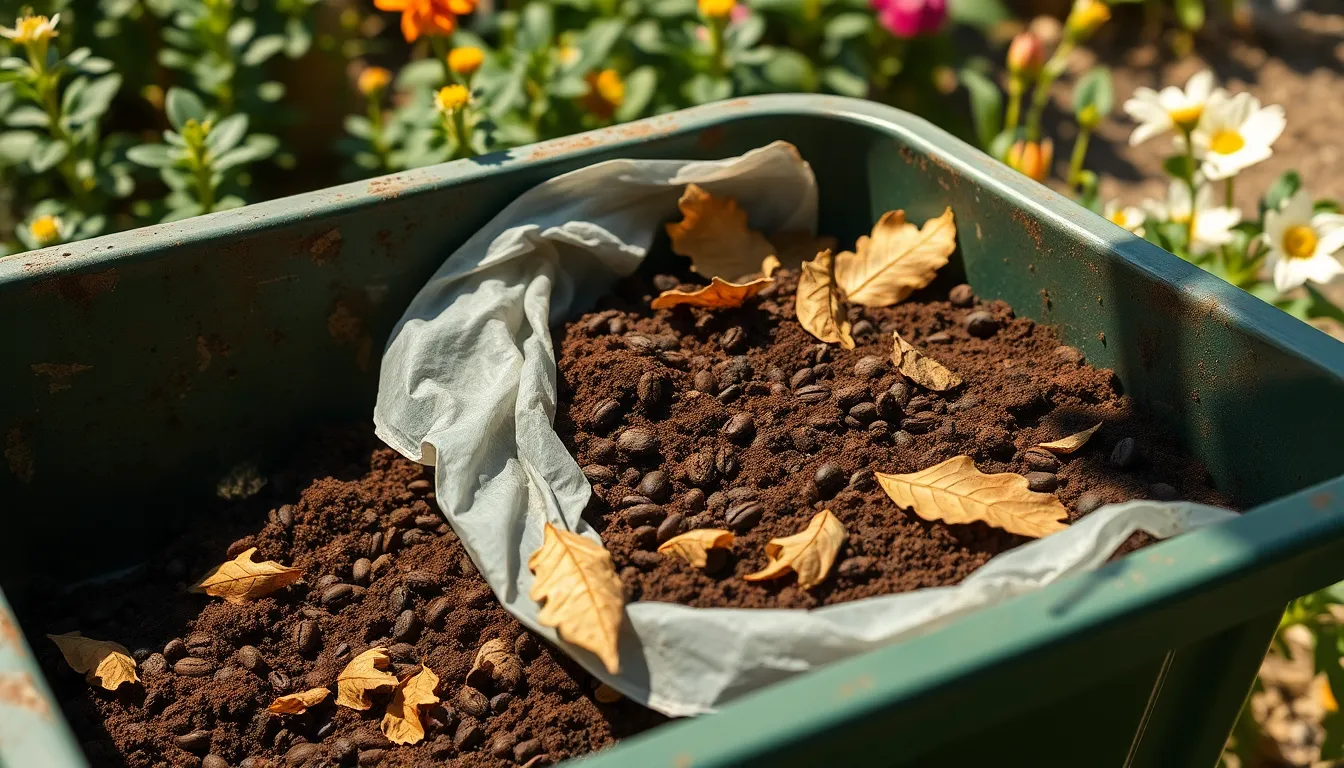
Proper preparation determines whether coffee grounds benefit or harm our plants. Research shows that applying unprepared grounds can damage root systems and disrupt soil chemistry.
Fresh Grounds Need Composting Time
Fresh coffee grounds contain high acidity levels and caffeine concentrations that can burn plant roots and negatively affect plant health. Studies indicate these compounds remain active for several weeks after brewing, making direct application dangerous for most garden plants.
Composting breaks down harmful caffeine and reduces acidity levels to safe ranges for plant growth. We recommend mixing fresh grounds with brown materials like dried leaves or paper in a 1:3 ratio to create balanced compost. The composting process typically requires 3-6 months to neutralize toxic compounds completely.
Temperature monitoring helps ensure proper decomposition occurs during the composting phase. Hot composting at 140-160°F accelerates the breakdown of caffeine and acidic compounds more effectively than cold composting methods.
Used Grounds Can Be Applied More Directly
Used coffee grounds have already undergone extraction, removing most harmful caffeine while maintaining beneficial nutrients like nitrogen, potassium, and phosphorus. Testing shows used grounds maintain a more neutral pH between 6.5-6.8, making them safer for immediate garden application.
Direct application works best when we sprinkle thin layers around established plants rather than creating thick barriers. Earthworms process used grounds more readily than fresh ones, helping incorporate nutrients into surrounding soil naturally.
Moisture content affects how quickly used grounds integrate with existing soil structure. Slightly damp grounds mix more effectively than completely dry ones, which can form water-resistant clumps that block nutrient flow.
Mixing Ratios Prevent Soil pH Imbalances
Balanced mixing prevents coffee grounds from overwhelming soil chemistry and creating conditions that harm plant roots. Research demonstrates that coffee grounds should comprise no more than 10-20% of total soil amendments to maintain optimal growing conditions.
Combining grounds with alkaline materials like crushed eggshells or wood ash helps neutralize any remaining acidity. We achieve best results when mixing one part coffee grounds with four parts regular compost or aged organic matter.
Soil testing before and after application ensures pH levels remain within acceptable ranges for exact plants. Most vegetables thrive in soil with pH between 6.0-7.0, while acid-loving plants prefer slightly lower levels around 5.5-6.5.
Coffee Grounds Should Be Applied Using Specific Methods
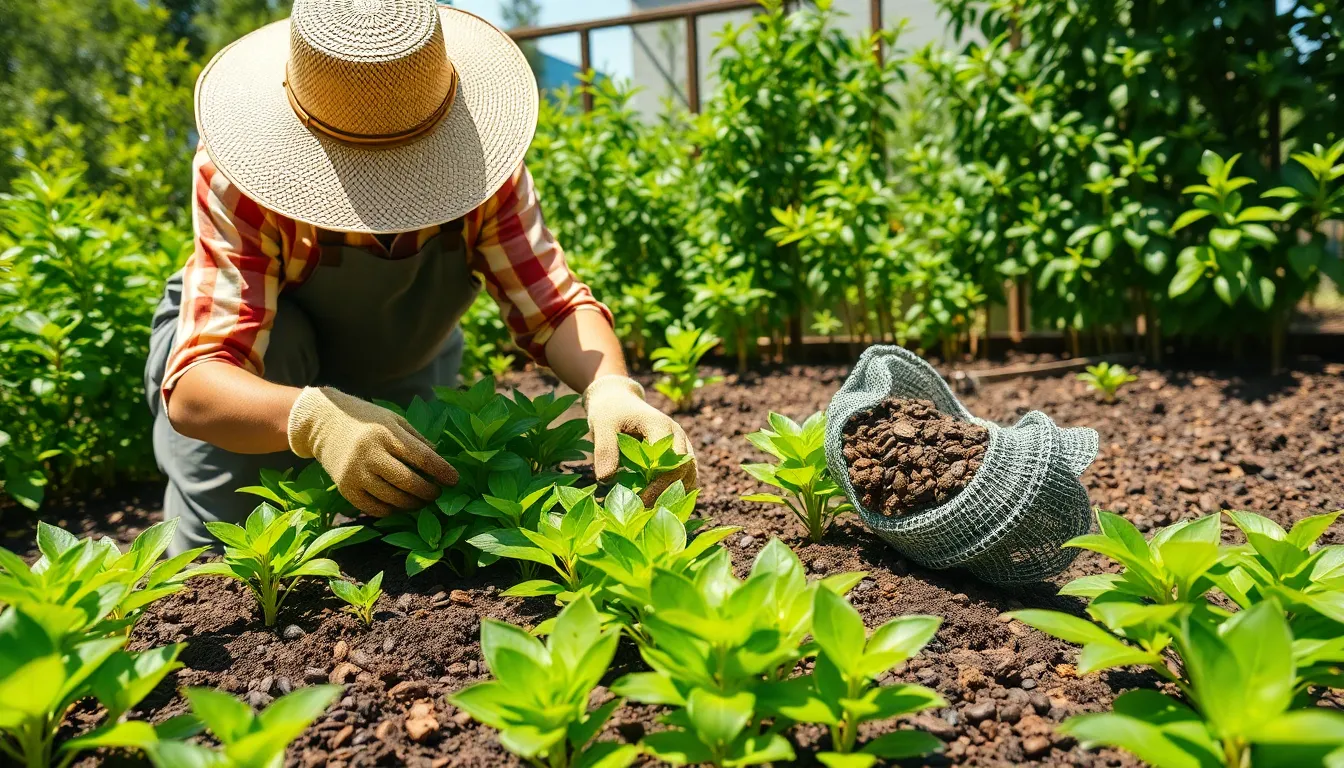
We’ve explored the remarkable benefits of coffee grounds for plants, but success depends on using proper application techniques that maximize their nutritional value while avoiding potential pitfalls.
Composting Creates the Most Balanced Amendment
Composting coffee grounds with other organic materials produces the most effective fertilizer for garden use. We recommend mixing coffee grounds with dry leaves or grass clippings to create a nutrient-rich amendment that neutralizes any remaining acidity. This process breaks down caffeine compounds that can harm plants when applied fresh, transforming coffee grounds into a safe soil enhancer.
The composting method improves soil texture significantly while improving both drainage and moisture retention capabilities. We suggest mixing composted coffee grounds thoroughly into existing soil or potting mixes to support healthy plant development. Balanced composting creates a slow-release fertilizer containing nitrogen, potassium, magnesium, calcium, phosphorus, and essential trace minerals like boron, copper, iron, and zinc.
Direct Application Works for Certain Plant Types
Used coffee grounds can be applied directly around plants as mulch or soil amendment due to their near-neutral pH levels. We find this method particularly effective for acid-loving plants like blueberries and azaleas, which benefit more from direct coffee ground applications than other plant varieties. Combining grounds with other mulch materials helps suppress weeds, retain soil moisture, and keep root systems cool during hot weather.
Proper mixing prevents coffee grounds from forming a water-blocking crust on soil surfaces. We recommend distributing thin layers around established plants and incorporating them gently into the top inch of soil. Direct application works best when coffee grounds comprise no more than 25% of the total mulch mixture.
Liquid Coffee Fertilizer Provides Quick Nutrients
Creating liquid fertilizer from coffee grounds offers rapid nutrient delivery for container plants and garden beds. We prepare this “coffee tea” by steeping approximately 2 cups of used grounds in 5 gallons of water overnight, creating a nutrient-rich solution. This method extracts water-soluble nutrients quickly, making them immediately available to plant roots.
The resulting liquid can be used for regular irrigation or applied as a foliar spray directly onto plant leaves. We’ve found this technique particularly effective for providing quick nitrogen boosts to leafy vegetables and supporting rapid growth during peak growing seasons. Liquid coffee fertilizer delivers nutrients faster than composted or directly applied grounds, making it ideal for addressing immediate plant nutritional needs.
Coffee Grounds Can Cause Problems When Used Incorrectly
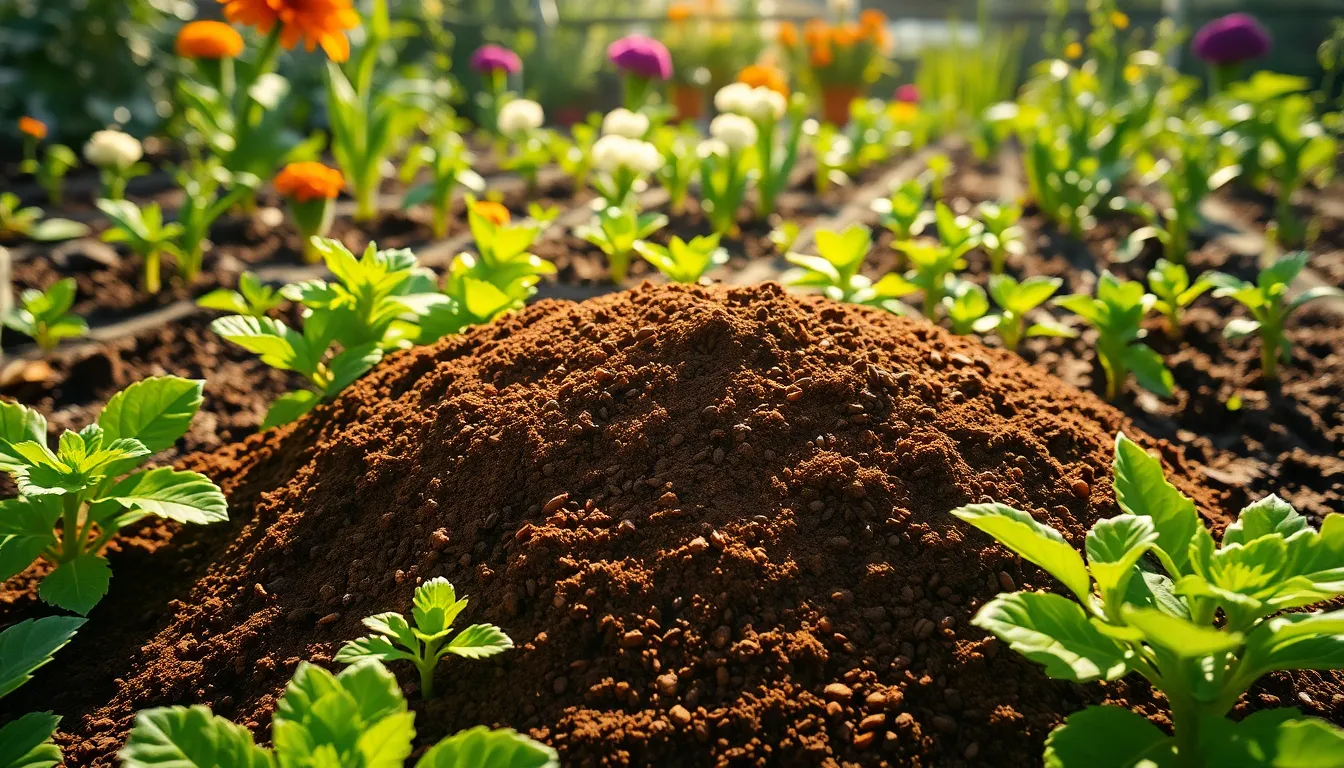
While coffee grounds offer tremendous benefits for our gardens, improper use can actually harm our plants and soil health. Understanding these potential issues helps us avoid common mistakes and maximize the positive effects.
Excessive Amounts Create Nitrogen Toxicity
Applying too much coffee grounds at once creates a dangerous nitrogen imbalance that can severely damage our plants. Fresh coffee grounds contain nitrogen compounds that microorganisms consume during decomposition, temporarily reducing the nitrogen available to our plants. This process can create nitrogen toxicity when we apply excessive amounts, causing leaf burn, stunted growth, and weakened root systems.
Research shows that only a small portion of the nitrogen in coffee grounds becomes immediately available to plants. The remainder requires microbial breakdown, which competes with our plants for existing soil nitrogen. We can prevent this problem by limiting applications to thin layers no more than half an inch thick and spacing applications several weeks apart.
Supplemental nitrogen fertilizer helps balance this effect when we’re using larger quantities of coffee grounds. Mixing coffee grounds with other organic materials before application also reduces the risk of nitrogen depletion and toxicity in our garden beds.
Fresh Grounds May Inhibit Seed Germination
Fresh coffee grounds contain chemical compounds that can prevent seeds from sprouting successfully in our gardens. These allelopathic substances naturally occur in uncomposted coffee grounds and create an environment hostile to germinating seeds. Studies demonstrate that fresh grounds significantly reduce germination rates across various plant species, making direct application around new plantings particularly problematic.
Composting coffee grounds for three to six months eliminates these germination inhibitors through natural decomposition processes. The microbial activity during composting breaks down the harmful compounds while preserving the beneficial nutrients our plants need. We should always compost fresh grounds before using them in areas where we plan to start seeds or transplant seedlings.
Used coffee grounds from our daily brewing pose less risk than fresh grounds since the brewing process removes many inhibitory compounds. But, we still recommend composting even used grounds when working with delicate seedlings or direct seeding projects.
Some Plants Cannot Tolerate Acidic Conditions
Coffee grounds create slightly acidic soil conditions that can harm plants requiring neutral or alkaline growing environments. Plants such as asparagus, beets, and most herbs prefer neutral to alkaline soils and may suffer reduced growth, nutrient deficiencies, and poor flowering when exposed to acidic amendments like coffee grounds.
Lavender, clematis, and other alkaline loving plants show particular sensitivity to coffee ground applications. These species require higher soil pH levels for optimal nutrient uptake and may develop yellowing foliage, stunted growth, or root problems in acidic conditions created by excessive coffee ground use.
We can test our soil pH before applying coffee grounds to determine compatibility with our existing plants. Mixing coffee grounds with alkaline materials like wood ash or limestone helps balance soil pH when we want to use grounds around acid sensitive plants. Alternatively, we should reserve coffee ground applications for acid loving species like blueberries, azaleas, and tomatoes that thrive in these conditions.
Conclusion
We’ve explored how coffee grounds can transform your garden into a thriving network. By understanding proper preparation methods and application techniques you can harness these nutrient-rich materials to boost soil quality and plant health.
The key lies in balanced application and patience. Whether you’re composting fresh grounds or using them directly around established plants the benefits extend far beyond basic nutrition. From attracting beneficial earthworms to deterring harmful pests coffee grounds offer a sustainable solution for multiple gardening challenges.
Remember to test your soil regularly and adjust applications based on your plants’ exact needs. With careful implementation coffee grounds become a powerful tool that supports healthier gardens while reducing household waste. Start incorporating this valuable resource today and watch your plants flourish with improved soil structure enhanced nutrition and natural pest protection.
Frequently Asked Questions
What nutrients do coffee grounds provide for plants?
Coffee grounds contain approximately 2% nitrogen for leafy green growth, 0.3% phosphorus for strong root systems and flower formation, and 0.6% potassium for overall plant health and disease resistance. These nutrients are released slowly, providing consistent nutrition throughout the growing season and supporting chlorophyll production, root development, and fruit formation.
How do coffee grounds improve soil quality?
Coffee grounds act as a natural soil conditioner by improving water retention in sandy soils and breaking up compacted clay structures for better aeration. They increase organic matter content, enhance soil fertility over time, and maintain a near-neutral pH suitable for most garden applications while creating optimal growing conditions.
Which plants benefit most from coffee grounds?
Acid-loving plants like blueberries, azaleas, and rhododendrons thrive with coffee ground amendments. Leafy vegetables such as lettuce and spinach benefit from the nitrogen content, while tomatoes show improved growth and disease resistance. Root vegetables and flowering plants also benefit from the phosphorus content for stronger development.
Do coffee grounds help with pest control?
Yes, coffee grounds naturally deter common garden pests. Research shows 1%-2% coffee solutions repel slugs and snails immediately. The strong aroma deters cats from garden areas, and coffee grounds can disrupt insect navigation, making plants less attractive to aphids and spider mites while maintaining beneficial insect populations.
Should I use fresh or used coffee grounds?
Used coffee grounds are safer for immediate application as they have neutral pH and lower caffeine content. Fresh coffee grounds should be composted for 3-6 months to neutralize harmful compounds and high acidity. Mix fresh grounds with brown materials in a 1:3 ratio during composting for best results.
How much coffee grounds should I apply to my garden?
Apply coffee grounds in thin layers to prevent nitrogen toxicity and soil pH imbalances. Limit applications and space them out over time. Mix coffee grounds with alkaline materials when needed and conduct soil tests to ensure optimal growing conditions. Excessive application can cause leaf burn and stunted growth.
Can coffee grounds harm plants or soil?
Yes, improper use can cause problems. Excessive application leads to nitrogen toxicity, while fresh grounds may inhibit seed germination due to allelopathic compounds. Plants preferring neutral or alkaline conditions may suffer from acidity. Always compost fresh grounds and test soil pH before application to prevent damage.

